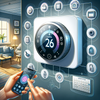Smart Meters are coming
The Australian Energy Market Commission (AEMC) is officially starting its Accelerating Smart Meter Deployment (ASMD) reforms. If you don’t already have a smart meter, you will by the end of 2030.
Smart home cooling systems offer precise control and improved efficiency. These systems not only cool homes more effectively but also adapt to user habits and preferences, leading to smarter energy use.

In the face of rising energy costs and environmental concerns, homeowners are increasingly turning to smart home cooling systems. By integrating energy-efficient air conditioning units with smart thermostats, these systems optimise home cooling, leading to significant energy savings and enhanced comfort.
This article explores the benefits of smart home cooling systems, how they work, and their impact on energy consumption and homeowner convenience.
Traditional air conditioning systems have been essential in providing comfort during hot seasons, but they are often energy-intensive and lack sophisticated controls. Smart home cooling systems represent a leap forward, offering precise control and improved efficiency. These systems not only cool homes more effectively but also adapt to user habits and preferences, leading to smarter energy use.
Smart home cooling systems combine the latest in air conditioning technology with smart thermostats and sometimes even integrate with broader home automation systems. Here’s how they enhance home cooling:
Smart thermostats are the central control units of these systems. They learn from your habits, such as when you're usually at home or away, and adjust the cooling accordingly. Features include:
The other key component is the air conditioning unit itself. Modern units are far more energy-efficient than older models and, when combined with a smart thermostat, can significantly reduce energy consumption.
These systems use a combination of sensors, algorithms, and user input to manage home cooling. Here’s a typical scenario:
The cost of smart home cooling systems includes the price of the energy-efficient air conditioner and the smart thermostat. While higher than traditional systems, these costs are continually decreasing as technology becomes more widespread.
The energy savings from these systems can be substantial. Many homeowners report significant reductions in their energy bills, often offsetting the initial investment within a few years.
Check for local rebates or incentive programs that support energy-efficient upgrades, as these can help mitigate initial costs.
When selecting a smart home cooling system, consider the following:
Proper installation is crucial for the efficiency of smart cooling systems. Regular maintenance, such as cleaning filters and servicing the AC unit, is also essential for optimal performance.
Numerous case studies and homeowner testimonials showcase the effectiveness of smart home cooling systems in reducing energy bills and improving comfort. For example, a study might illustrate how a family reduced their cooling costs by 20% after installing a smart system.
The future of smart home cooling systems is promising, with advancements in AI, machine learning, and integration with broader smart home ecosystems. This will lead to even more intuitive and energy-efficient systems.
While the upfront cost is higher, the long-term savings in energy bills can be significant. Additionally, many homeowners find the enhanced comfort and convenience to be worth the investment.
For those not tech-savvy, modern smart thermostats are designed to be user-friendly, with intuitive interfaces and easy-to-use apps.
Investing in a smart home cooling system is a smart move for homeowners looking to reduce their energy bills, improve home comfort, and contribute to environmental sustainability. The combination of smart thermostats and energy-efficient air conditioners represents the cutting edge of home cooling technology. As technology advances, these systems will become even more efficient and user-friendly, making them an indispensable part of modern, energy-conscious living. With the potential for significant cost savings and increased comfort, switching to a smart home cooling system is an investment worth considering for any homeowner.
Savings as a Service is the blog site and newsletter from Bill Hero. Subscribe now and get your energy savings tips and information delivered fresh to your inbox every month.